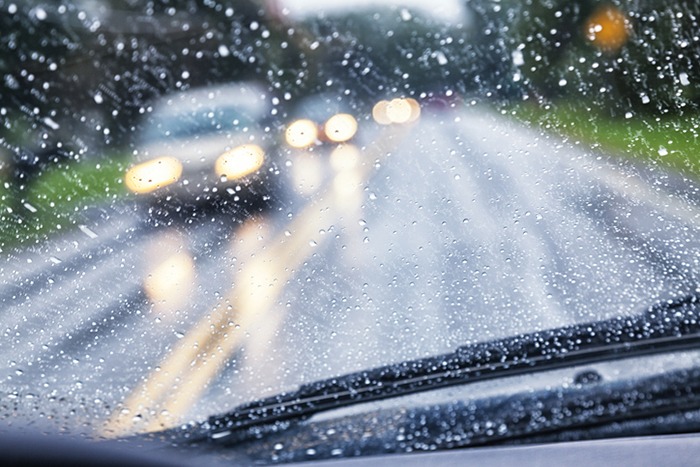Tips for Driving in the Rain

Driver POV (point of view) looking over the windshield wipers through the wet, blurry, partially opaque, partially transparent, spot speckled windshield of a car traveling on a rural highway during an autumn rain storm. Hazy, blurred headlights of approaching vehicle traffic are just blobs of light through the streaking and splattered raindrop water. Canon 5D Mark III.
A recent study found that driving in rain increases the likelihood of fatal car crashes by 34%. Slick roads and low visibility make a dangerous combination. Plus, water pooled on the road creates a serious hydroplane risk.
But there are steps you can take to reduce your risks while behind the wheel during a storm. Here are our top four tips for driving in rain.
Turn Your Headlights On
Your headlights aren’t just for nighttime driving. Even if it’s the middle of the day, turn your headlights on while driving in rain. It will help you see better. And, just as importantly, it will help other drivers see you better.
You might not think headlights would help much, but the National Highway Traffic Safety Administration (NHTSA) found that headlight use reduced daytime crashes from light trucks and vans by nearly 6%!
Keep Your Car Well-Maintained
Proper car maintenance is always important. But especially while you’re driving in rain. Here are three key maintenance items for safe driving in rain:
-
Tires. Solid tread and proper inflation will help your car grip the wet, slippery road.
-
Windshield wipers. Old wipers can leave streaks of water across your windshield, which can distort lights and make it harder to see.
-
Brakes. When visibility is low because of rain, you might need to stop suddenly. And that requires good brakes. Get your brakes and brake fluid checked regularly.
Skip the Cruise Control
Cruise control is for long, open roads that you can see stretched out in front of you for miles. If it’s raining, you can’t see as far, so you need to be ready to react quickly. Plus, if you come across standing water on the road, you could hydroplane. And hydroplaning with cruise control is extra dangerous because the lost traction can trick your system into speeding up.
What to Do if You Hydroplane
If you find yourself hydroplaning:
-
Ease off the accelerator.
-
Don’t yank the steering wheel; try to keep it straight, making only gentle adjustments.
-
Do not slam on the breaks. This can cause the car to skid violently to the side, potentially taking you off the road or into other vehicles.
Practice Smart Driving Behavior
Smart driving means adjusting your driving to meet changing road conditions. Driving in rain, or any other bad weather, requires some extra care:
-
Keep your distance. If the driver in front of you hydroplanes, brakes suddenly, or hits something, you want to have plenty of time to avoid them.
-
Slow down. Slower speeds will make it easier to see what’s coming and respond correctly.
-
Avoid distractions. This is not the time to be changing music, snacking, or doing anything that takes your focus off the road.
-
Be patient. It will take you a little longer to get where you’re doing. And you may encounter extra traffic. That’s okay. The most important thing is your safety.
-
Expect the unexpected from other drivers. Other drivers might not be as cautious as you are. And you don’t want their bad driving to create a dangerous situation for you. A defensive driving class will teach you to watch for other drivers and account for their driving mistakes.
- Make sure you have the right insurance coverage. Your friends at Apollo Insurance Services can compare rates from up to 25 A+ insurance companies to get the right coverage to protect you in case of an unexpected accident. Call us at 800.426.1088 to find out more.
